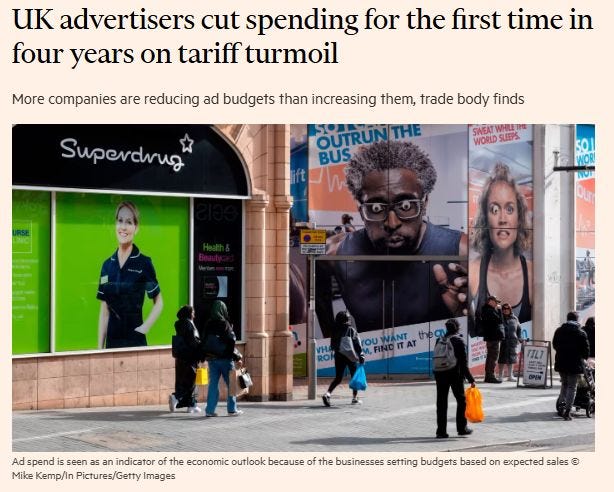Can your Instagram feed predict a recession?
In the era of low interest rates, I was running significant ad spend on products priced against the BoE’s base rate.
As rates rose, the advertising moved from ultra-profitable to loss-making.
A recent Financial Times article reminded me of the relationship between economics and marketing.
UK ad spend declined in Q1 2025.
This data point aligns with recent conversations I’ve had with major advertising networks - brands are pulling back.
Ad spend is a leading indicator of economic activity.
When consumers are feeling the squeeze of inflation, and have less disposal income, businesses cut budgets.
What’s interesting is how this shift plays out in the auction mechanics of digital advertising platforms.
Ad inventory is often priced dynamically, and, with some gross simplification, digital real estate is sold to the highest bidder.
Consider two worlds:
→ In a strong economy
-A “travel ad” might generate a 2% CTR.
-For every 100 people who see it, 2 click—and a portion of those convert.
-The customer acquisition cost (CAC) might look healthy.
→ In a downturn
-That same ad might only see a 1% CTR.
-Same spend, half the engagement. CAC just doubled.
-And platforms penalise poor CTRs with higher CPMs… so it's a double hit.
If CAC rises, and margins shrink, advertisers have a decision to make.
Should they lower bids, pause campaigns altogether, or shift budgets to alternative audiences?
The result would lead to a “crowding out” of that “travel ad” on advertising networks.
The ad inventory would be sold instead to offers which do better in deteriorating economic environments.
Think:
→ Short-term liquidity solutions
(Credit products, BNPL, or side-income apps)
→ Education & upskilling
(Courses, certifications, bootcamps)
→ Income-generating tools
(Freelancing platforms, creator tools, or new jobs)
Social feeds evolve to reflect economic moods.
“Product-market” and “channel-market” fit are more dynamic to time than they first appear.
Fit isn’t a static thing.
It’s shaped by markets, incentives, and consumer mindset.
The companies that stay ahead are often the ones that evolve.

